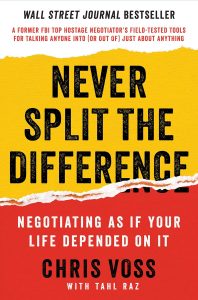What We’re Reading: “Never Split the Difference” by Chris Voss
Never Split the Difference by Chris Voss
Everyone who deals with various work and life situations should learn how to negotiate successfully
 I recently picked up the book Never Split the Difference: Negotiating As If Your Life Depended On It by Chris Voss, after someone recommended it in a meeting I attended.
I recently picked up the book Never Split the Difference: Negotiating As If Your Life Depended On It by Chris Voss, after someone recommended it in a meeting I attended.
Chris Voss started his career in Kansas City, Missouri as an international hostage negotiator with the FBI. He was the FBI’s lead negotiator in situations with a wide range of criminals, such as bank robbers, terrorists, kidnappers, etc. Then Voss went from his key role as an FBI negotiator to his current life situation as head of the Black Swan Group, teaching negotiation skills to business men and women.
In Never Split the Difference, Voss shares many effective principles, strategies, and tactics everyone can use to become more persuasive in their personal and professional life.
For example, you could use some of his strategies when you venture out to buy a car or a home, negotiate your salary, or deliberate with your business partner, spouse, or child. Here are a few of his negotiating techniques that were of interest to me.
Voss explains that negotiations should be approached with the mindset of discovery. This means having the goal to extract as much information as possible. When negotiating, you need to make your counterparty feel understood and positively affirmed. Then you can engage the party in a conversation that will lead them to say, “That’s right,” instead of just, “Yes.” Voss says “that’s right” is a great winning strategy, and oftentimes means the negotiation has been successful.
Another tactic Voss shares is something he calls “label it.” This approach is designed to create trust and tactical empathy so that you can better learn your counterpart’s perspective, and then gain their trust. Labels such as “it seems like,” “it sounds like,” or “it looks like,” can help to defuse negative emotions. Voss describes how people’s emotions have two layers – there is an external side and internal side – and the second layer requires understanding the person’s state of mind, and then offering a solution.
Finally, “bending reality” is a tool Voss puts forward for framing a negotiation in a way the counterparty accepts the limits placed in the discussion. When you “bend reality,” you deploy the idea of fairness and push the person you are negotiating with to realize if they don’t accept your offer, it would be a huge loss to them. In short, you show them that no deal at all is better than what they may perceive as a bad deal.
We can all apply Voss’s negotiation methods to our daily experiences in the workplace. In reflecting on my role as Executive Manager at the Foundation, I see where I have already used some of these tactics myself. Recently, we completed a major capital project on our building, and I had to negotiate with the contractors who performed the work. I frequently have dealings with all sorts of vendors and volunteers, and having read his book, I can see where opportunities exist for richer conversations where we both understand each other’s positions and are able to reach mutually beneficial solutions.
